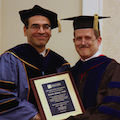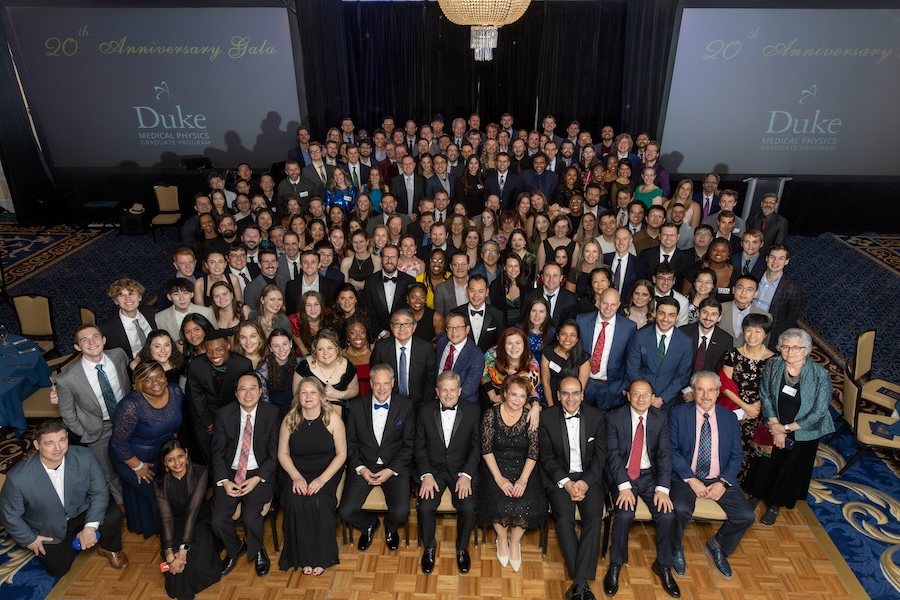
by Sarah Brady
20 years. Over 340 students graduated. 260+ publications, 440+ scientific presentations, 120+ internal and external awards for students for academic and research excellence.

By the numbers, it’s obvious that the Duke Medical Physics Graduate Program (MPGP) has made an indelible impact on the field in the two decades it’s been in existence. Program Director and Professor of Radiation Oncology Mark Oldham, PhD, described how, at this milestone, it’s critical to take a breath and reflect on achievements to-date – and also to dream of what may lie ahead. “There are many unsung heroes that make the program what it is, and I feel tremendous gratitude,” he said. “So many students, faculty and staff have devoted hard work and effort and experienced so many moments of struggle, personal growth, human connection, joyful achievement and proud impactful scientific contribution during our time in the program.”

But the MPGP of today, a thriving program that graduated 19 PhD and MS students in 2024, with a strong alumni base whose graduates have found success in the fields of clinical physics, industry and academia, didn’t start this way – it took a lot of early effort to get it off the ground, spearheaded by Founding Director Emeritus (2005-2015) James “Jim” Dobbins III, PhD (pictured right), and Founding Director of Graduate Studies and former Director (2015-2020) Ehsan Samei, PhD (pictured left).
From Early Collaborations to Formal Education
The program’s roots trace back to early morning research meetings in the 1990s, where imaging physicists in the Department of Radiology and Carl Ravin, MD – then chair of Radiology – gathered to discuss the evolving field of digital imaging. Conversations eventually shifted toward the concept of a dedicated medical physics graduate program, housed in the Departments of Radiology and Radiation Oncology, which would help physicists in both departments “expand their academic and clinical work through collaboration,” Dr. Dobbins explained, “and expand the impact of Duke scholarship on the field of medical physics as a whole.”
In 2000, Dr. Samei, a newly hired medical physicist and assistant professor in radiology, re-energized discussions. “With a strong and growing cohort of nearly 60 medical physicist faculty at Duke,” he said, “the time seemed ripe for considering a new educational initiative that would better capture the strengths of Duke in medical physics into a formal training program.”

Launching the program was no easy feat. A steering committee was formed, led by Dr. Dobbins and supported by Dr. Samei. A yearlong feasibility study was conducted; a preliminary proposal was created; and eventually the proposal earned the support of seven department chairs – including Chair of Radiation Oncology Christopher Willett, MD, who was also a strong support for the program’s creation – as well as five deans, four university committees and, finally, the Duke Board of Trustees.

Establishing the Duke MPGP: A New Era in Medical Physics Education
On December 3, 2004, the Duke MPGP was officially minted, marking the first truly new PhD program at Duke in 13 years, and the first ever PhD program initiated from clinical departments. “There were many times when it seemed that we were at critical points when a single decision or event would determine whether we failed or succeeded,” said Dr. Dobbins. “While these challenges presented risks and gave us anxiety on occasion, we remembered that few things of value come about in life without hard work and some measure of risk.”
The program welcomed its first class in the fall of 2005 after a whirlwind abbreviated recruitment season and only eight months to draft a curriculum (designed with four tracks of specialization, a first in medical physics education). By 2007, the program had secured an NIH training grant; the program was accredited by the Commission on Accreditation of Medical Physics Education Programs (CAMPEP) in 2008, and subsequently every five years since then.
Global Impact and Lasting Connections
Today, the program has become a cornerstone of medical education and research at Duke – and beyond. It’s no exaggeration to say that the program has had national and international acclaim and impact. In 2008, Drs. Dobbins and Samei initiated the creation of the Society of Directors of Academic Medical Physics Programs (SDAMPP), which continues to play a critical role in guiding medical physics educational standards nationwide. And in 2014, a second Duke medical physics graduate program, headed by Fang-Fang Yin, PhD, and Dr. Dobbins, was launched at Duke Kunshan University in China. In 2020, Dr. Oldham took the reins as program director, with Joseph Lo, PhD – professor in radiology; electrical and computer engineering; and biomedical engineering – as associate director. As the COVID-19 pandemic set in, the leadership team pivoted to continue to ensure the same level of excellence in teaching and research.

My message to all future students is simple: be curious and explore as much as possible. The opportunities to learn via exposure at Duke are endless.
— Current MS student Lauren Neldner
In addition to concrete, measurable accomplishments, the program has other benefits. “One of the most meaningful and impactful aspects of our time in the program are the relationships and shared experiences between students, faculty, and staff at all levels,” said Dr. Oldham. Students and alumni describe the program as a “close-knit family” that has such “a unique way of building friendships and bonds,” and a “safe haven for students to make lifelong friends and develop relationships.”

Many former students are now faculty in the program, including Chunhao Wang, PhD, who emphasized the strong program connections: “As an alumnus, if I have any questions, I can reach out to my classmates. It’s pretty amazing that once I click send, I usually can get a reply in ten minutes. I don’t think you can find this type of strong network and community everywhere. Once Duke, forever Duke.”

As an alumnus, if I have any questions, I can reach out to my classmates. I don’t think you can find this type of community everywhere. Once Duke, forever Duke.
— Faculty Chunhao Wang, PhD
Celebrating the Past and Shaping the Future: The MPGP’s Next Chapter
“There is much to be proud and thankful for in what our program has given us and the world over the last 20 years,” said Dr. Oldham. “But our anniversary celebrations are not only a celebration of the past, but also the start of the future.”
Looking ahead, the program’s future is bright. “It is clear we can expect great advances inspired by powerful and transformative new technologies and discoveries that are occurring throughout medicine and science,” said Dr. Oldham. “Medical physicists, with their unique combination of expertise in the hard sciences and deep clinical experience, are uniquely well positioned to lead in this area and bring a promising future to fruition.” Beyond technological advances, in 2021 the MPGP recruited a class that was majority female for the first time.

Alumnus Jackie Maurer, PhD, who was a member of one the first cohorts of students and is now a medical physicist at Bozeman Health Deaconess Cancer Center in Bozeman, Montana, recalled her time at Duke fondly: “I hope that the future of the Duke medical physics program will continue with the passion, pride and commitment that I experienced. I feel that I received an exceptionally well-rounded education and was challenged and grew in so many ways personally and professionally. I hope those values remain at the center of the program.”
Dr. Oldham is confident that, with the strong leadership team, the cross-departmental collaborations, the exceptional student base and the feeling of “forever Duke” permeating the program, there are good things ahead. “Here’s to the next 20 years!” he said. “May they be even more exciting, rewarding and impactful than the prior.”